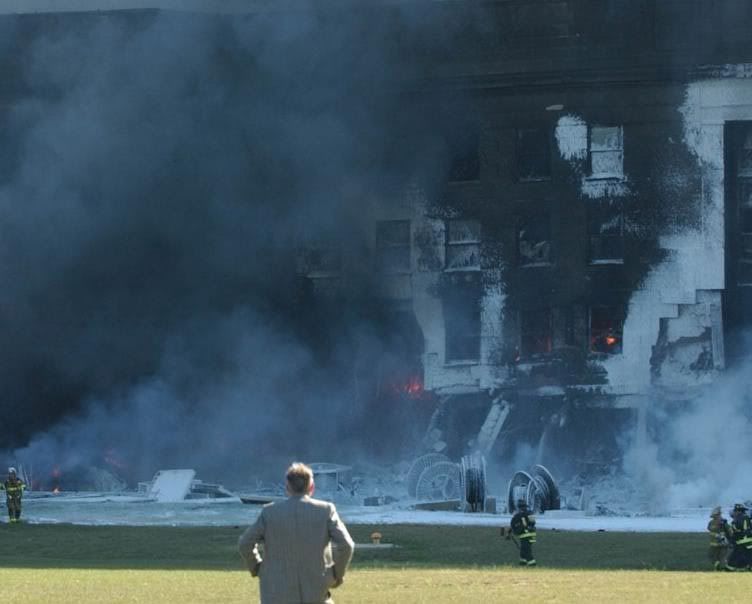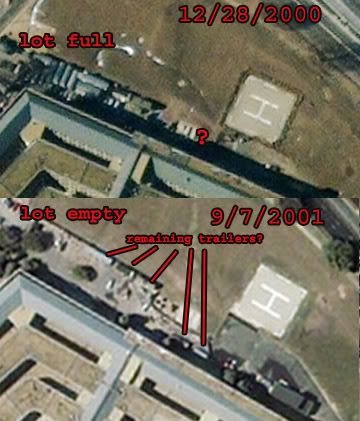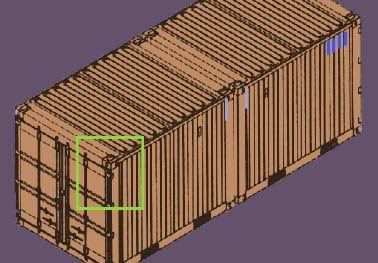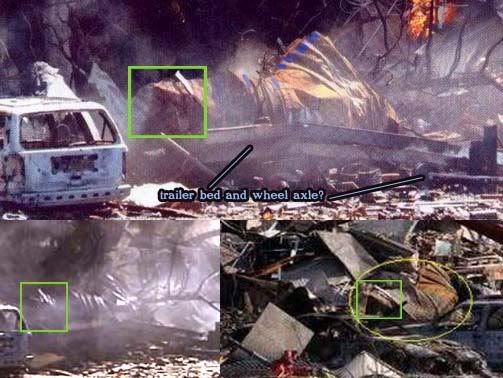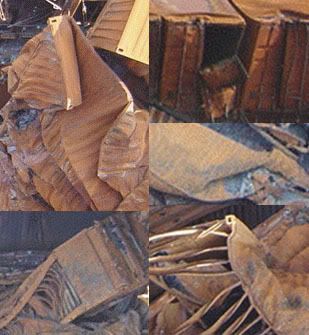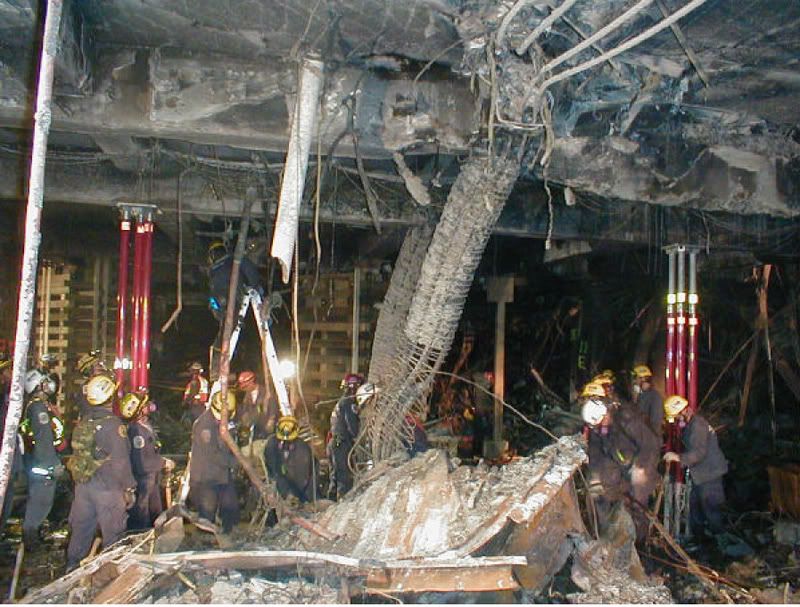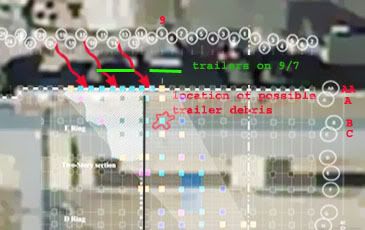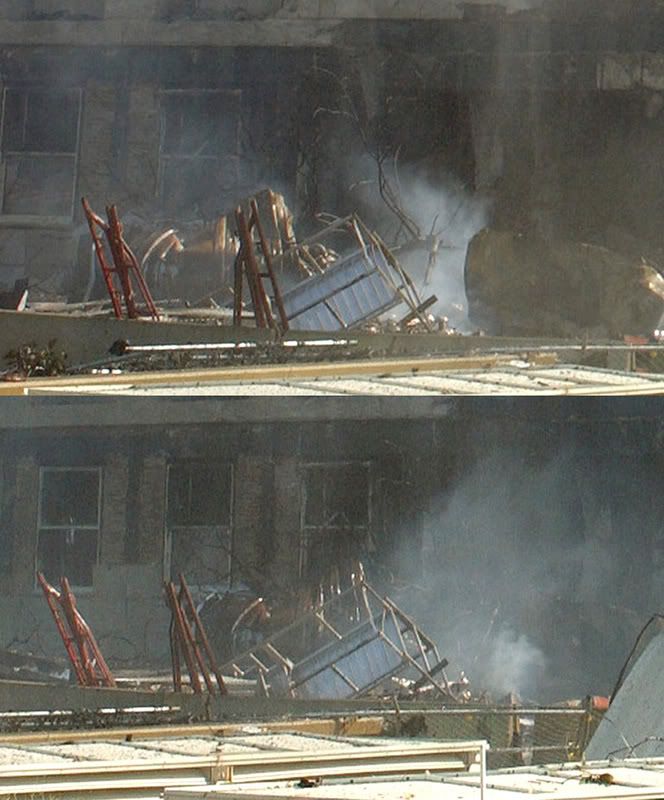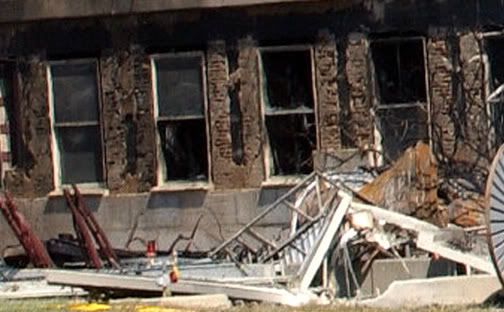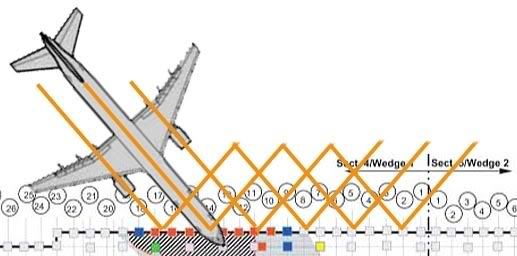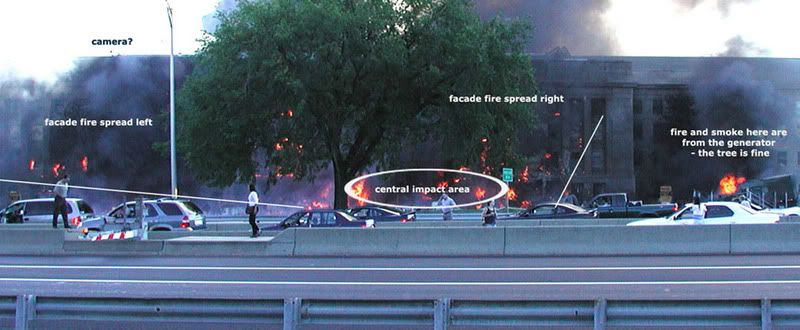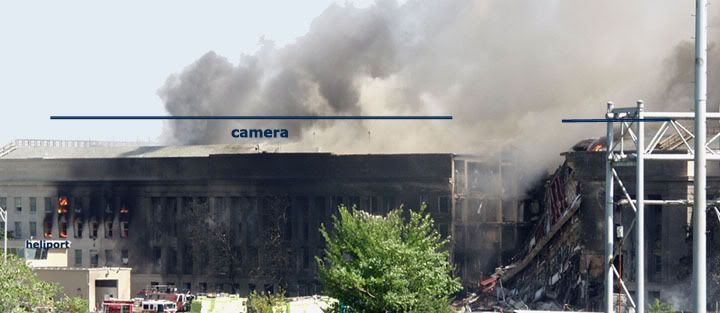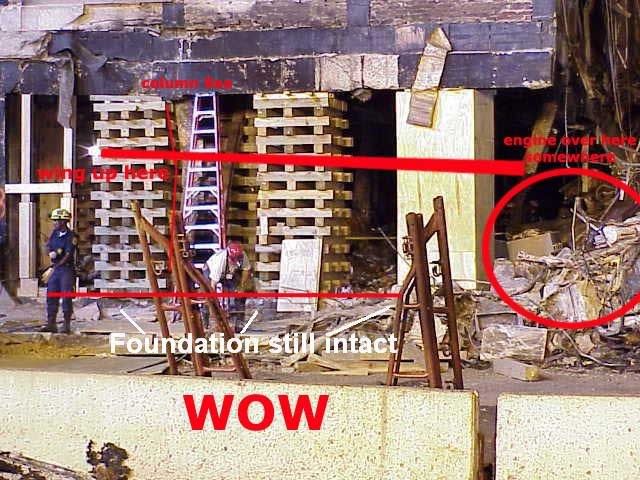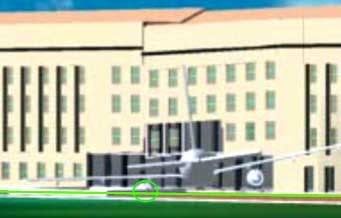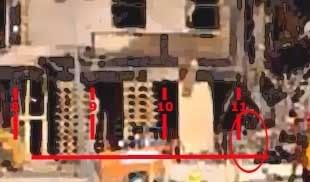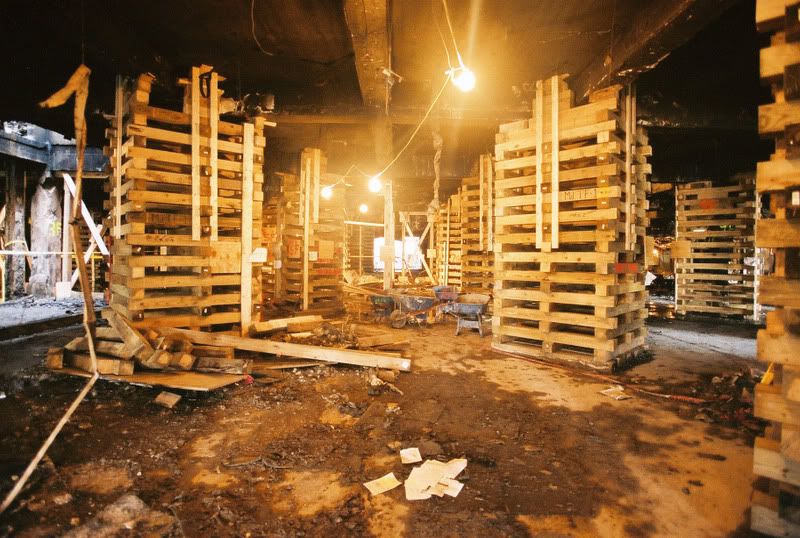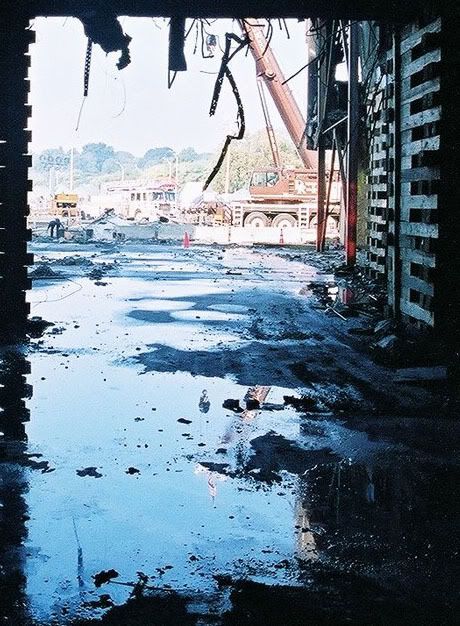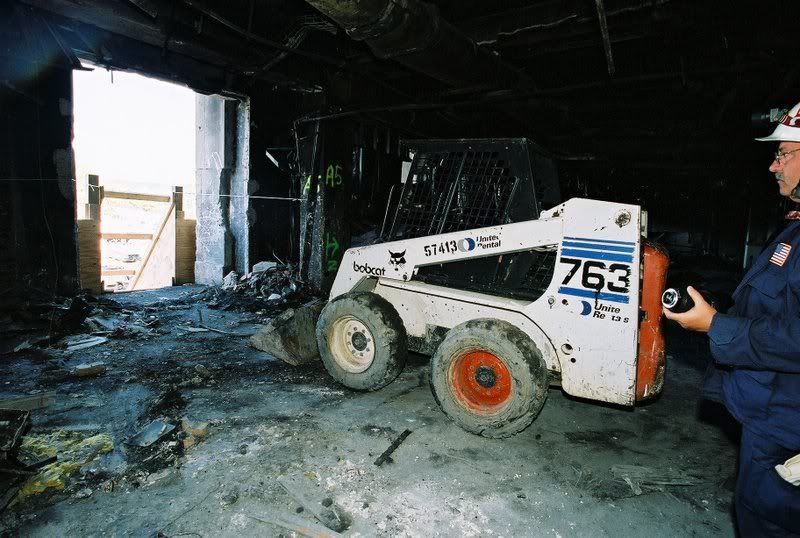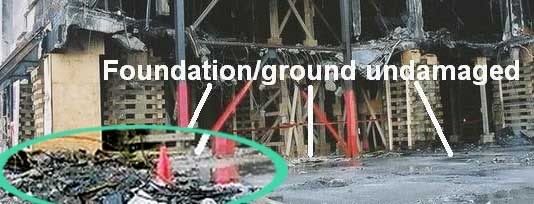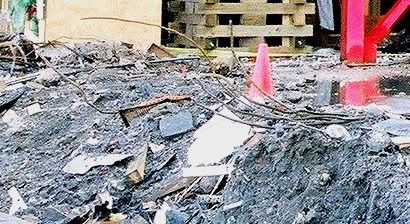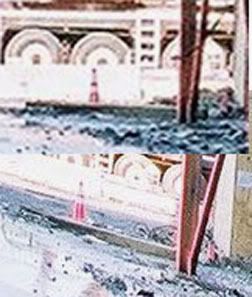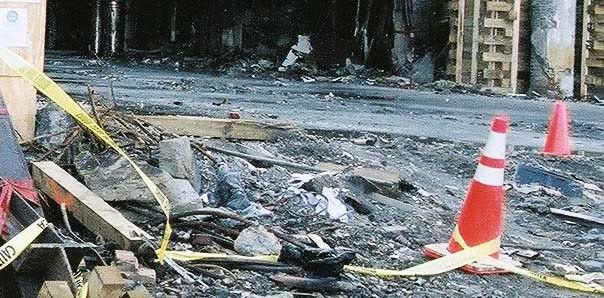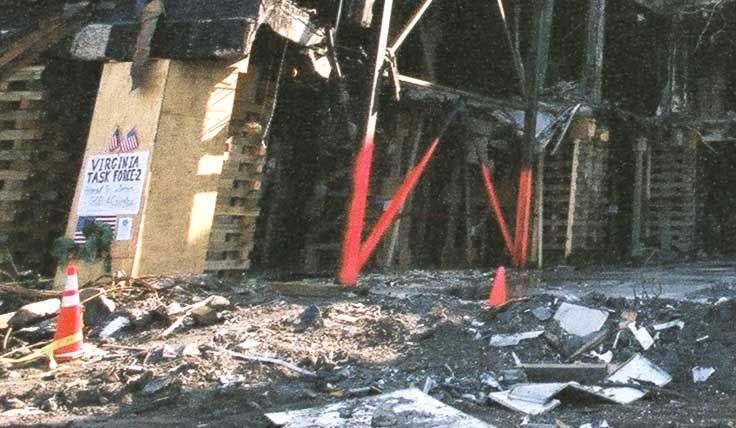Adam Larson / Caustic Logic
The Frustrating Fraud
February 10 2008
Citizen Investigative Team’s number one claim to fame is of course their trailblazing eyewitness account verification, proving a north-of-the-Citgo flyover of the Pentagon. But garnering less attention is their groundbreaking work on exploring the ‘smoking gun’ physical evidence there was no impact from any airliner. Besides the witnesses, and before they were known of at all, CIT felt they had a strong anti-crash case, based on research into the ‘anomolous’ physical evidence at the site of the anomalous (alleged) impact of a 757 into the Pentagon.
Among the prime points they have made and that I’ve so far addressed is the presence of Column 14AA on the second floor, and the lack of foundation damage. The next claim I will examine and answer to the best of my ability is “why is there no continuity to the "wing damage" when it tilted up its right wing? It looks as if the facade simply fell off in this section.” This question was posted along with the two above and several others at Above Top Secret.com, and illustrated with these two high-res Jason Ingersoll photos:

 The area shown here is just south of the main impact hole, the first and second floors of the section just upgraded to withstand bomb blasts. In the middle span there is much visible damage: a windowless panel recently backed with 10” of steel-reinforce concrete, intact but missing most facing and partially scooped-out. Perhaps most odd is another panel of presumably the same type right below it entirely gone, along with two weaker window/door panels just to the right of these. Some limestone facing is removed from the frame to the right of that, but at the left and right are areas of little or no visible damage, labeled in red “no wing.” On first blush this might seem like pretty anomalous damage, considering the alleged wing impact angle (see below); put simply, there’s too much damage on the first floor, and apparently not enough on the second.
The area shown here is just south of the main impact hole, the first and second floors of the section just upgraded to withstand bomb blasts. In the middle span there is much visible damage: a windowless panel recently backed with 10” of steel-reinforce concrete, intact but missing most facing and partially scooped-out. Perhaps most odd is another panel of presumably the same type right below it entirely gone, along with two weaker window/door panels just to the right of these. Some limestone facing is removed from the frame to the right of that, but at the left and right are areas of little or no visible damage, labeled in red “no wing.” On first blush this might seem like pretty anomalous damage, considering the alleged wing impact angle (see below); put simply, there’s too much damage on the first floor, and apparently not enough on the second. The photo below is overlaid with a light grid representing the intact structural frame. Intact panels within the grid are lightened as well, whereas removed or intensely damaged panels are left un-tinted. The partial plane outline is based on the ASCE’s graphics, layered to scale and outlined. Areas shaded red are where the problem is, those marked ‘no wing’ above.
 Considering how much continuity of damage there should be, we need to consider many factors, like these:
Considering how much continuity of damage there should be, we need to consider many factors, like these:1) The strength of the wing at various point in optimal conditions
2) Actual wings strength/integrity after impacting light poles, generator, etc.
3) The mass and speed behind the wing (with the fuselage already shredding inside)
4) By the alleged impact angle, the entire right wing would have impacted near-simultaneously
4) Portions of the building impacted – horizontal resistance (floor slab) vs. vertical resistance (columns, wall panels, windows)
5) The possibility of other projectiles (cargo trailers, equipment, etc) and/or the deflagration plume of a pre-impact wing explosion contributing to the extra damage on the ground floor.
Considering these, one red area is near the wing’s mid-point just over and south of the engine. This is a very strong part of the wing, but it met the floor slab at a shallow angle – near parallel - with at least ten feet of it hitting edgewise either the slab or the very bases of the columns anchored to it above. At this point, the building wins and shows no immediately visible scars. The other problem area is nearer the wing’s tip, a weaker point, meeting ordinary columns and façade, if the outer wing was even still attached at that point. The wall south of CL 20 shows nary a sign of impact, so apparently building wins there as well, which somehow doesn’t surprise me.
But further in on the wing, which was after all attached to a barreling 90-ton jetliner at about 460 kts, there should have been some instant damage to the frame. Countering this CIT point at the forums, I’ve previously used the following two images of the damaged panel between columns 18 and 19, cropped from Jocelyn Agustino hish-res photos taken – yes, I’m aware - about a week after the event:
 The missing brick has a linear edge with a certain slope relative to horizontal. The concrete backing damage has its own similar overall slope. The slab and column damage as well exhibit a similar but shallower slope. The damage is manifested at different heights due to the nature of the materials, their order in layering, etc., but all share a moderate right-high slope that is consistent with the alleged wing tilt of the 757 at impact.
The missing brick has a linear edge with a certain slope relative to horizontal. The concrete backing damage has its own similar overall slope. The slab and column damage as well exhibit a similar but shallower slope. The damage is manifested at different heights due to the nature of the materials, their order in layering, etc., but all share a moderate right-high slope that is consistent with the alleged wing tilt of the 757 at impact.  Seen from something of a side view, as above, it’s clearly visible that the columns are disjointed, with the upper floor’s lower ends apparently buckled inward, or the lower ones outward, it’s not entirely clear. Referring to this area of damage, the ASCE’s Pentagon Building Performance Report noted:
Seen from something of a side view, as above, it’s clearly visible that the columns are disjointed, with the upper floor’s lower ends apparently buckled inward, or the lower ones outward, it’s not entirely clear. Referring to this area of damage, the ASCE’s Pentagon Building Performance Report noted:“Just above the second-floor slab, the exterior columns on column lines 18 and 19 exhibited aligning gashes that seem to indicate impact by the right wing of the aircraft [...] An area of broken limestone of the facade over the exterior column on column line 20 also aligned with these gashes.” [p 27/28 - emph mine]
Referring to these photos presented as evidence, and apparently missing the majority of information in them, Ranke said “the damage does NOT match a "wing". […] A single broken column does not match a "wing" and does not have to have been fabricated on purpose to match a wing.” He decided I was “incorrectly or deceptively trying to attribute damage to the "plane" that did not exist immediately after the violent event,” rather than to the collapse or some other later event. [source]
In fact, noting the lack of all this damage visible before the collapse, I attribute it to a chain of events unlocked by the plane’s impact. Let’s look at a different kind of continuity of wing damage - continuity through time. At impact the initial damage would be done in a tiny fraction of a second. Some of this – the missing and damaged panels - was externally visible. There would also be damage, especially along the stronger frame, that would be internal and less visible.
Considering both obvious and possibly latent damage, let’s look at a sequence of pictures from the morning of 9/11, at different points between 9:38 and 10:15 or so. In Steve Riskus’ photo at left, taken about one minute after impact, CL18 is framed by magenta markers and a line of fire just to its right. This long-shot is too unclear on its own, but compared to the Darryl Donley photo at center and taken at least five minutes after, it shows a flaming seam at its far right that matches, if more dimly. The Ingersoll shot at right was taken several minutes later and after a coating of fire retardant foam. While the facing is broken fairly clean on the column edge, the “no plane” damage area to the left of that remains unchanged; the column and its facing remain - counter-intuitively - intact.
 At lower left in the top photo below, note a major crack in the horizontal frame just to the left of column 18. I speculate that at this point, the area there is holding together by weight and habit, but ready to shear, crumble, and scatter along the fault lines introduced by the big thud at 9:38, waiting for a further violent event to trigger the fractures into rifts.
At lower left in the top photo below, note a major crack in the horizontal frame just to the left of column 18. I speculate that at this point, the area there is holding together by weight and habit, but ready to shear, crumble, and scatter along the fault lines introduced by the big thud at 9:38, waiting for a further violent event to trigger the fractures into rifts.  Then the collapse, immediately after which the bottom shot was taken. The facing around the damaged panel has fallen away, but the brick and concrete backing remain about the same. Below that, something has left the whole corner of the frame above and left of column 18 missing, presumably in the pile large of rubble that formed at the foot of the collapsed zone. Perhaps it was some massive pressure that has stripped away the top of that column, exposing re-bar. Although the separation came after the collapse, the point of give is right about there in the red zone of ‘no plane damage.’ And I’m pretty sure column 19 on the right also shows its later damage at this point, and even before collapse, though that’s less clear. Coincidence? If there was no continuity of wing damage, then why is there no continuity of the column here?
Then the collapse, immediately after which the bottom shot was taken. The facing around the damaged panel has fallen away, but the brick and concrete backing remain about the same. Below that, something has left the whole corner of the frame above and left of column 18 missing, presumably in the pile large of rubble that formed at the foot of the collapsed zone. Perhaps it was some massive pressure that has stripped away the top of that column, exposing re-bar. Although the separation came after the collapse, the point of give is right about there in the red zone of ‘no plane damage.’ And I’m pretty sure column 19 on the right also shows its later damage at this point, and even before collapse, though that’s less clear. Coincidence? If there was no continuity of wing damage, then why is there no continuity of the column here? Referring to Augustino's post-shoring photos of the alleged wing gash, Ranke told Above Top Secret.com member Dark Blue Sky, in no uncertain terms:
“You can't use a post collapse photo if you are trying to assert it was from the alleged impact. Catherder used the same image for the same reason and it's deceived many 10's of thousands of people. Please don't help. There is nothing possible about the damage to the Pentagon in relation to a 757 impact.” [source]
Referring to a blurrier version of the bottom post-collapse shot above that clearly shows the breach of column 18, Ranke furter explained “it's quite clear that even after the collapse the left column was not completely breeched as it was after supports were added days later.” [source] Wrong. It might have been worse by the time of Augustino's photos, but it could only be less clear here due to being a head-on shot. The top of the column’s casing is gone, the corner of the frame is gone, lengths of rebar are exposed, and column 19 seems to have its damage as well, visible even before the collapse.
In summary then, all things considered, the answer to CIT’s original question is that there is about as much continuity to the right wing damage as there should be, which is little that was plainly visible after impact, but more that revealed itself after the collapse. And again I'm only left wondering if they really misread the evidence this wrong or are just pretending to have done so.

